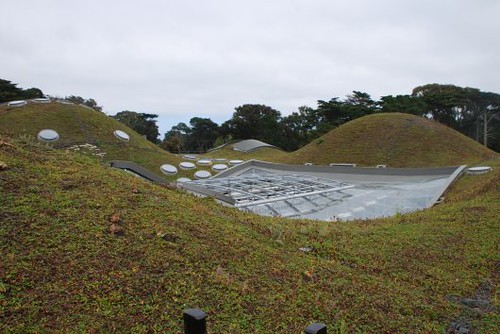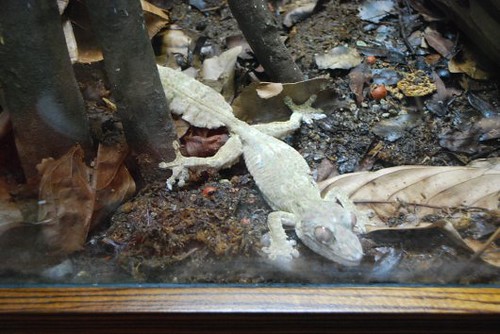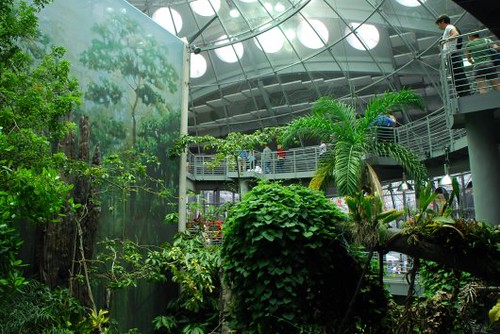California Academy of Sciences offers a good excuse for a San Francisco getaway
SAN FRANCISCO—Last week, your East Oahu Editor was on a much-needed trip off island with her husband, Ian, and two daughters, Maia and Aurelia. We had a family wedding in Palo Alto, followed by a family reunion in Lake Tahoe. In between, we had about 36 hours in San Francisco, one of my favorite cities. I knew it would be a tease to blow through this town so quickly, especially since we were saddled with young children and unable to take much advantage of its myriad dining, shopping, art, and nightlife opportunities. Yet I mandated the brief stop for two reasons: to check in with some of our old college friends, and to visit the newly re-envisioned California Academy of Sciences.
The California Academy of Sciences, known locally in the Bay Area as “The Academy”, is not a new institution. It has roots back to 1853, when it emerged as the first society of its kind in the United States. Then called The California Academy of Natural Sciences, it sought to undertake “a thorough systematic survey of every portion of the state and the collection of a cabinet of her rare and rich productions.” Later renamed the more inclusive California Academy of Sciences, it opened its first museum space in 1874. The 1906 earthquake destroyed the second, larger incarnation of the museum; the current site in Golden Gate Park opened in 1916.
Besides serving as a museum, the Academy is a formidable research institution in numerous branches of biology, botany, anthropology, geology, and paleontology, with an emphasis on environmental concerns permeating the various departments and creating opportunities for collaboration.
This focus on ecology and sustainability was at the heart of architect Renzo Piano vision for the new building, which was nearly ten years in the making. In 2008, $500 million later, the current structure opened with great fanfare and critical acclaim. Now the world’s greenest museum, it boasts numerous unique and environmentally-friendly design features ranging from recycled construction materials to its use of rainwater for irrigation, earning it Platinum certification under the Leadership in Energy and Environmental Design (LEED) program. In fact, it is the largest public building in the world to have achieved this status. At the same time, it retains several architectural elements from the old structure, including a significant portion of the facade.
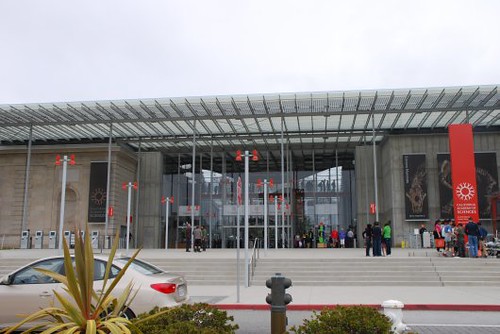
The current Academy contains an aquarium, planetarium, natural history museum, and a four-story rainforest. It also houses the Academy science labs and administrative offices, including an extensive library and a scientific archive consisting of more than 26 million specimens. In addition, there’s a 3D theater, a lecture hall, a Naturalist Center, two restaurants, an adjacent garden and aviary, a roof terrace, and a store.
It was a typically dreary and foggy July day in San Francisco, and we piled on the layers before heading to Golden Gate Park. We were accompanied by our friend Kurt and his two children, as well as our friend Amy, and her toddler. Both families are annual pass holders who frequent the museum on a regular basis, so they were able to both get us into the museum for free, as well as give us the inside track on how to maximize our experience.
Despite it being a Monday, the place was packed when we arrived. Just beyond the information booth is a piazza, which bisects the two domes that serve as the focal points of the museum: Rainforests of the World on the right and the planetarium on the left. It was barely noon, yet the planetarium had already sold out for the day and lines for the other attractions were long, though not prohibitively so.
After briefly taking in the impressive building, which was flooded with light despite the lack of sun outside (90 percent of the building’s occupied spaces use natural light), we decided to get something to eat before tackling the many exciting exhibits on offer.
Here I must briefly digress from discussing the awesome architecture and science to discuss a less obvious but certainly noteworthy attraction of the Academy: food. The museum offers two restaurants to choose from: the Moss Room, a refined “farm-to-table” dining experience, and the Academy Cafe, a self-service, kid-friendly, and considerably less expensive option. We opted for the latter, and were bowled over by the variety and quality of food on offer.
In keeping with Academy’s mission and San Francisco’s dining tendencies as a whole, the Cafe took affordable, sustainable dining to new heights. The entrees ranged from $6.00 to $12.50, and showcased locally-sourced and often organic takes on international offerings, conceived in a series of stations with such minimalist titles as “steamed,” “soup”, and “noodles” (and serving up items like tamales, Posole, and Whole Wheat Rigatoni with Duck Sausage, respectively). I opted for a vegetarian bun from the “steamed” station and a chicken pho from the “soup.”
My friend Amy shared Moroccan Chicken with her son from the “Slow Cooked” station; my husband had a Cuban panini from “Sandwiches”—you get the idea of how diverse the food is. Sometimes such variety results in mediocre execution, but this is not the case with the Academy Cafe. The green theme carried on throughout and even after the meal. All packaging was biodegradable or compostable, and patrons were urged to separate waste matter into compost, recycle, or rubbish bins.
Sufficiently fortified, we went straight to one of the museum’s highlights, Rainforests of the World. The line to enter this four-story dome was long but moved quickly and continuously. Once inside, the visitor is rewarded with a multi-sensory rainforest experience.
The first thing we noticed was the increase in temperature. Off came the jackets and sweaters; the temperature inside the dome is kept at 82-85 degrees Fahrenheit and the humidity at 75 percent or above. Our friends joked that it felt like Hawaii inside the dome, and indeed it did.
As we followed a spiraling path up through the exhibit, we encountered a marvelous array of wildlife. Each of the four floors represented a different rainforest region: Borneo, Madagascar, Costa Rica, and the Amazon. Highlights included bats from Borneo—a first for our children—as well as the chameleons, geckos, and other animals from Madagascar. Many of these creatures are unique to that island and a spectacle to behold, such as the nocturnal Henkel’s leaf-tailed gecko, which is a far cry from Hawaii geckos with its pale coloring, almost disturbingly bulbous eyes, and tail that is shaped like, well, a leaf.
The 250 free-flying birds and butterflies proved to be favorites, as did the lush tropical trees and plants that were largely responsible for authentic atmosphere.
The Academy would be worth a visit on the merits of its collections alone, but the genius of the architecture not only greatly enhances a visitor’s experience with the exhibits but warrants a visit in its own right. One powerful example of how the building’s design contributes to the overall impact of the museum’s offerings is the way in which the Rainforest dome connects to the Aquarium below. At the base of the rainforest is a flooded forest, with catfish and arapaima swimming through it. This ecosystem is visible both from above and beneath. From the rainforest dome, you can look down through the water to see the people in the Aquarium below. It is an ingenious way to connect the environments both physically and metaphorically.
We chose to link the exhibits by taking the glass elevator down from the rainforest’s fourth floor into the lower level, taking in the sensorial splendor of the rainforest one last time along the way. Once inside the aquarium’s Amazon Flooded Forest, an acrylic tunnel enabled us to walk beneath the fish swimming overhead—a feature that was cool for kids, sure, but equally fun for adults.
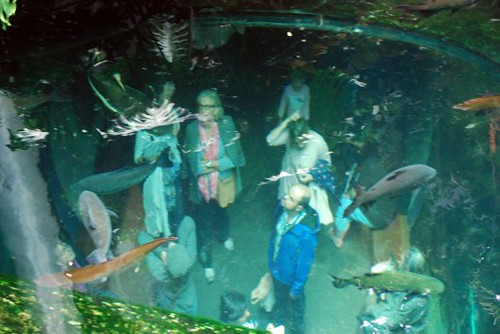
Visiting the Steinhart Aquarium is an extensive activity in itself. My five-year old Maia spent over 30 minutes just looking at the enormous Philippine Coral Reef Gallery, one of the deepest exhibits of live coral in the world, and teeming with stingrays (her current fascination), sharks, and over 2,000 colorful fish.
The children also enjoyed the Discovery Tidepool, where knowledgeable volunteers facilitated a hands-on experience with sea stars, hermit crabs, and other coastal creatures. I naturally gravitated towards the eels, where I could get close and personal with their creepy yet comical expressions.
Another standout was the Water Planet, with its rotating exhibits. The current display featured staff favorites with explanations for why they selected their particular animals. There I encountered the waxy monkey tree frog, a most unusual amphibian. It was immediately apparent why Alison Rusch, Animal Health Technician, liked this frog, with its bright green waxy appearance (designed to help lock in moisture) and its tendency to swing through the branches rather than hop.
By this time, the younger members of our group were wearing thin so we had to abandon the idea of seeing the entire collection. We took a quick peek at the Swamp and its albino alligator; the African Hall and its dioramas of classic animals from this continent, some of them live, such as the African penguins; and Islands of Evolution, which cleverly tell the story of evolution from the specific examples of Madagascar and the Galapagos. Both the Swamp and the African Hall predate the new building.
As I mentioned previously, we were unable to visit the Planetarium that day since it had sold out by noon. However, we would not have been able to do it anyway, as children should be at least six years old (and are not allowed to enter if under three). If interested, it is advised to arrive early and go straight to the Planetarium kiosk, as tickets are handed out on a first come, first serve basis. The current show, Journey to the Stars, is narrated by Whoopi Goldberg.
We capped off our day with a visit to the Living Roof, one of the primary reasons I wanted to visit the Academy in the first place and the crowning achievement of this LEED building. This 2.5 acre expanse of native California plants and wildflowers provides a habitat for bees, birds, and butterflies, thereby simultaneously serving as an energy-efficient roof and a parkland.
It offers superior insulation, prevents storm water runoff, and reduces the “Urban Heat Island” effect (not that I’ve ever witnessed an excess of heat in San Francisco, but certainly this model would be a boon for other cities such as Honolulu). The rooftop is comprised of seven hillocks, creating a micro version of San Francisco’s hilly topography. The views from the roof are also wonderful, especially that onto the also newly remodeled yet already iconic De Young Museum. If there was any comfort in only being allowed a quick visit to San Francisco, having the opportunity to take in the city from such an innovative and inspired vantage point was it.
The California Academy of Sciences is located at 55 Music Concourse Dr., Golden Gate Park, in San Francisco. They can be reached at (415) 379-8000. Regular hours are Monday through Saturday, 9:30 a.m. to 5:30 p.m.; Sunday, 11:00 a.m. to 5:00 p.m. In general, it is advised to purchase tickets to the California Academy of Sciences online, in advance. General admission to the Academy is $24.95. You can plan your visit and get a good sense of the place by visiting the Academy’s wonderfully thorough website: http://www.calacademy.org/
